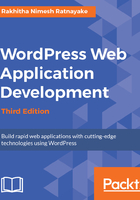
Implementing Membership Roles, Permissions, and Features
The success of any web application or website depends heavily on its user base. There are plenty of great web applications that go unnoticed by many people due to the lack of user interaction. As developers, it's our responsibility to build a simple and interactive user management process, as visitors decide whether to stay on or leave a website by looking at the complexity of initial tasks such as registration and login.
In this chapter, we will be mainly concentrating on adapting existing user management functionalities into typical web applications. In order to accomplish our goal, we will execute some tasks outside the box to bring user management features from the WordPress core to WordPress themes.
While striving to build a better user experience, we will also take a look at some advanced aspects of web application development, such as routing, controlling, and custom templating.
In this chapter, we will cover the following topics:
- Introducing user management
- Understanding user roles and capabilities
- Creating a simple MVC-like process
- Implementing registration on the frontend
- Implementing login on the frontend
- Time to practice with exercises
Before we get started, I suggest that you skip ahead to Appendix, Configurations, Tools, and Resources and configure the WordPress environment and setup required for this book. I assume that you are familiar with the default user management features and necessary coding techniques in WordPress. So, let's get started!